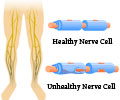The neuroprotective effect of thalidomide against ischemia through the cereblon-mediated repression of AMPK activity has been proved by recent research. Thalidomide may suppress nerve cell death
- The drug thalidomide may have a neuroprotective effect.
- Neuroprotective effect refers to the ability to protect nerve cells from being damaged.
- Thalidomide is also known for its side effect which results in severe birth defects.
To investigate, scientists at Waseda University and Tokyo University of Pharmacy and Life Sciences studied thalidomide's target protein, cereblon (CRBN), and its binding protein, AMP-activated protein kinase (AMPK), which plays an important role in maintaining intracellular energy homeostasis in the brain. Through their study, they revealed that thalidomide inhibits the activity of AMPK via CRBN under oxidative stress and suppresses nerve cell death.
Specifically, Sawamura's research group used cerebral ischemia model rats of the cerebral artery occlusion/reperfusion (MCAO/R) to examine the effect of thalidomide on infarct lesions caused by cerebral ischemia and related intracellular signals. After performing qualitative analysis and assessments on the rats' physical movements, they found that thalidomide treatment significantly decreased the infarct volume and neurological deficits in MCAO/R model rats, and that AMPK was the key signaling protein in the mechanism through additional experiments.
The mechanism behind the ability of thalidomide to protect nerve cell death
Moreover, to determine the molecular mechanisms of the effect of thalidomide on neuronal death, they used oxidative stress-induced neuronal cells, which were induced by administration of H2O2, as cerebral ischemia model cells. "In these cells, we found that the AMPK-CRBN interaction weakened and phosphorylation of AMPK enhanced, but thalidomide treatment restored the AMPK-CRBN interaction and suppressed phosphorylation of AMPK," explains Sawamura. "What this implies is that thalidomide regulates AMPK-CRBN interactions in cells under ischemic conditions, meaning, it can suppress nerve cell death."
Further study is needed to identify effective thalidomide derivatives with fewer side effects, as well as more stability because they undergo hydrolysis spontaneously and rapidly in aqueous solutions. Nevertheless, Sawamura is excited about the future possibilities of this study.
"Our attention is now on the functions of CRBN as a stress response molecule. The suppression of nerve cell death by thalidomide perhaps occurs because CRBN's function as a stress molecule is somehow enhanced. We want to elucidate the response of cereblons in aging and stress models to see if decline in the CRBN function could be a biomarker for aging and stress."
- Naoya Sawamura, Mariko Yamada et al. The Neuroprotective Effect of Thalidomide against Ischemia through the Cereblon-mediated Repression of AMPK Activity, Scientific Reports doi:10.1038/s41598-018-20911-2
Source-Eurekalert













